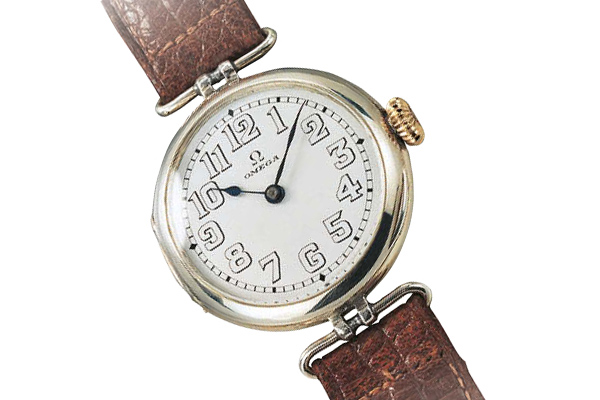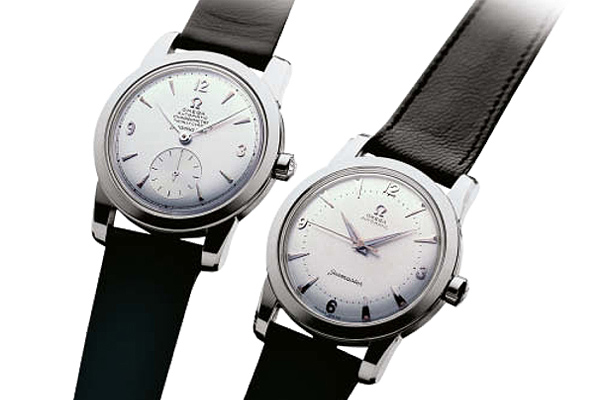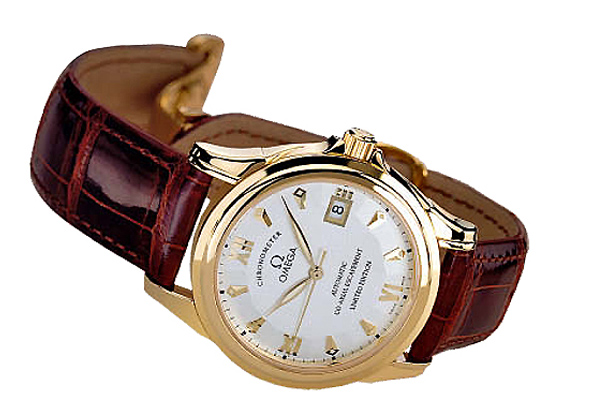WatchTime Wednesday: the History of Omega Watches in 7 timepieces

Since its inception in 1892, the History of Omega Watches has been long and full of many interesting, even essential, timepieces. Alongside the Speedmaster and the Seamaster, many other watches had been milestones for the Bienne-brand. Lots of iconic models, many technical innovations, such as the co-axial escapement or the first fully antimagnetic movement: Omega is clearly one of the top and key brands of the industry. Here are 7 timepieces, selected by our friends form WatchTime, that made the history of Omega Watches.
First Minute-Repeater Wristwatch (1892)
The world’s first minute-repeater wristwatch was unveiled in September 1892 by the Bienne, Switzerland firm of Louis Brandt & Frère, precursor to today’s Omega watch company. Brandt had chosen Audemars Piguet in Le Brassus to modify a 13-ligne Lépine ébauche that Audemars had purchased from the ebauche maker LeCoultre & Cie. The striking mechanism was triggered by a slide at 3 o’clock. The complex wristwatch case strongly resembles that of a pocketwatch. Engraved on the dust cover is a phrase in French that translates as “Excluded from the competition: juror, Paris 1889.” The engraving suggests that the watch had been exhibited at the Chicago World’s Fair in 1893, but had not been allowed to participate in the competition for medals because César Brandt, who ran the firm with his brother Louis-Paul, had served on the jury of the Paris World’s Fair in 1889.

First Omega Wristwatch (1900)
The first wristwatches bearing the Omega name were produced in 1900 and used by British officers in South Africa’s Boer War (1899-1903). Omega was one of the first firms to begin serial production of wristwatches. The watches withstood the rough treatment they got. An Omega advertisement in a watchmakers’ magazine in Leipzig in 1904 publicized the testimony of a British artillery officer whose Omega wristwatch performed admirably in bitter cold, searing heat, torrential rain and merciless sandstorms. The lieutenant colonel concluded that “The wristwatch is an essential campaign element.” The wristwatches were powered by a Lépine 12-ligne Caliber HN B and were available in two versions: one with the crown on the right, to be worn on the left wrist, and the other with the crown on the left for wearing on the right wrist.

Omega Seamaster (1948)
René Bannwart is considered the father of the Omega Seamaster line. The man who would later found Corum had begun building Omega’s design department in 1940. This was new. At that time, sketches for new models were usually drawn by draftsmen in watch-case factories. Bannwart’s decision set Omega on a new path that other brands would soon follow. To celebrate Omega’s 100th anniversary, Omega sales director Adolphe Vallat asked Bannwart to develop a sporty, robust and waterproof wristwatch. Bannwart felt that Vallat wasn’t giving him enough time, so he presented one of his case designs with the comment “much too clunky.” To Bannwart’s surprise, Vallat was delighted. The result was the Seamaster family. It had its origins in watches supplied to Britain’s Royal Air Force in World War II. The 1948 civilian version of the pilots’ watch had a water-resistant case (to 50 meters), a screwed caseback with lead gaskets, a reinforced crystal, a silvered dial, and polished and riveted Arabic numerals. The version with small seconds, which was also available as a certified chronometer, contained the new automatic Caliber 28.10 RA RG-343. The model with a central seconds hand was the 28.10 RA SC-350.
The Seamaster is certainly one of the most important watches from Omega: from vintage 1970s chronographs to modern diving tools and vintage-inspired re-editions, it brought all the innovations into a single product line and thus is essential to understand the history of the Bienne-based manufacture.

Omega Constellation (1952)
Omega began using the name “Constellation” in 1952 to denote its officially certified wrist chronometers. The premier model was powered by Caliber 28.10 RA SC PC RG AM (nicknamed the “352”), which first appeared in 1945. This caliber wound itself via a unidirectional hammer-type winding weight. It also featured an indirectly propelled central seconds hand. The 28.1-mm-diameter, 5.4-mm-thick movement passed the official chronometer tests with flying colors. Its sturdiness, reliability and precision prompted Omega to produce the Constellation in large numbers. This model was also Omega’s first serially manufactured wristwatch chronometer.

Omega Speedmaster (1957)
The Omega Speedmaster, destined to become the most famous chronograph in the world because of its use by NASA for the Apollo program, was introduced in 1957. But the Speedmaster story really begins in 1943 with chronograph Caliber 27 CHRO C12, developed by Jacques Reymond. Born into a long-established family of watchmakers, Reymond had joined Omega’s subsidiary Lemania in 1942. The “CHRO” in the caliber designation stood for “chronograph,” the “27” referred to the movement’s diameter in millimeters, and “C12” denoted the additional counter for 12 elapsed hours. Further developed by Albert Piguet in 1946 and christened by Omega with the shorter name “321,” this movement was the smallest of its type at the time. Credit for the Speedmaster case design belonged to a group at Lemania, including designer Claude Baillod, prototype-maker Georges Hartmann and machinist Désiré Faivre. The watch’s salient features were a black dial, luminous hands, a tachymeter scale, water-resistant case, screwed back and domed Plexiglas crystal. The diameter was originally 39 mm. A 40-mm version with the tachymeter scale on a black background along the flange appeared in 1960. The ‘Speedy’ is still an important timepiece in Omega’s collection and modern editions, such as the Speedmaster Mark II or the classical Professional Moonwatch, continue to use this legendary past.

Omega De Ville (1967)
Omega launched De Ville as a separate line in 1967. It had been a collection within the Seamaster line since 1960. Simpler, younger, more colorful, and more varied than the Seamaster, it quickly became Omega’s best-selling collection. The name stood for an entire philosophy because the De Ville wasn’t created at Omega’s headquarters in industrial Bienne, but in sophisticated Geneva. The collection was intended to represent a new urban elegance. The designers had sought and found a modernistic element in wristwatch design. The collection included rectangular models containing the ultra-slim hand-wound Caliber 620. The synthesis of modernity and timelessness turned out to be just right. Omega De Ville wristwatches won six “Golden Roses” at the Baden-Baden design awards in the 1970s as well as the coveted Grand Prix Triomphe de l’Excellence Européenne. Modern editions of the Deville share this same spirit of elegance and timeless design, such as the Omega DeVille Hour Vision does.

First Co-Axial Escapement (1999)
The Omega De Ville Co-Axial contained automatic Caliber 2500, the first wrist chronometer with a co-axial escapement. The escapement was invented by English master watchmaker George Daniels. Omega developed Daniels’s design so that it could be manufactured in large quantities. Caliber 2500 was a modified self-winding movement from Omega’s Swatch Group sister, ETA. The co-axial escapement went a long way toward solving two fundamental problems that had plagued long- lasting precision timekeeping. First, every change in the viscosity of the lubricant oil detracted from the regularity of the rate behavior. Second, over time, the oil gradually disappeared from the locations where it was most needed in the movement. Daniels revised the architecture of the impulse-giving elements to reduce both the friction and the influence that the lubricant’s viscosity exerted on the balance’s amplitude. Unlike conventional escapements, his co-axial escapement consists of an intervening wheel, a co-axial wheel and a lever with three pallet jewels. The lever acts only when the balance swings counter-clockwise. To fully exploit the advantages of this escapement, 27-jewel Caliber 2500 had a Glucydur balance with a frequency of 28,800 vph and a flat, freely swinging hairspring. The movement debuted in a simple round case for which Omega reactivated the name “De Ville.”

The story doesn’t end yet as in 2014 Omega comes with another great innovation, the first fully antimagnetic movement, that can easily resist magnetic fields up to 15,000 Gauss. A new milestone for the brand that will, without any doubt, continue to make us dream by being one of the leading manufacture of Switzerland.
The original article was published on watchtime.com and is republished here with permission.




6 responses
I have the DeVille that belonged to my great grand father. It is still working better than my Rolex did. My grandfather bought it back in the early 1970’s in little Rock Arkansas, USA. I WOULD LIKE TO KNOW WHERE I CAN HAVE IT CLEANED AND INSPECTED. AND A NEW CRYSTAL PUT ON IT? It still keeps good time it just needs a good cleaning and a crystal. Thank you
Best timepiece I’ve ever had.
“I WOULD LIKE TO KNOW WHERE I CAN HAVE IT CLEANED AND INSPECTED.”
I would take it to a watchmaker.
In 2007 Omega launches their most important milestone, the Hour Vision with the 8500 movement. Omega called the Co-Axial movement a turning point for Omega and calibre 8500 the cornerstone of a new series of calibres. This specific calibre is the rehabilitation of a long lasting tradition of in-house manufacturing and emotional calibre 8500 can been seen as the rebirth of Omega. All together the calibre 8500 is a revolutionary horological milestone and a real historical Omega icon.
For cleaning old Omega watches you can contact Omega, that will be expensive though. Another possibility is to contact watchguy in the UK
Hi, does anyone knows the case reference of the Omega Seamaster seen in the third picture of this post?
It would be the omega with cal 343 movement, which has small second.
Thanks